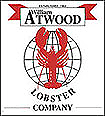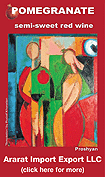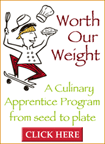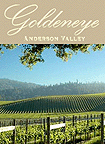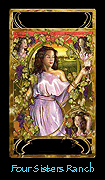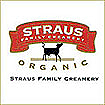
Mrs.
Charles Darwin’s
Recipe Book
Dusha Bateson
and Weslie Janeway
Preface by Janet Browne and Foreword by Nach Waxman
Charles
Darwin’s name is recognized around the globe and his discoveries
have shaped our understanding of the natural world. While the
scientist pursued research and theory, his wife Emma Wedgwood
Darwin, like many women of her time, kept a notebook filled
with recipes, culinary instructions and personal anecdotes about
everyday life in the Darwin household. Authors Dusha Bateson
and Weslie Janeway have recreated and tested every one of Mrs.
Darwin’s 55 recipes and put them in a new cookbook, Mrs.
Charles Darwin’s Recipe Book: Revived and Illustrated
(Glitterati Inc.; November 2008; $35.00/hardcover; ISBN-13:
978-0-9801557-3-0). This unique cookbook offers a rare glimpse
behind the dining room doors of one of the Victorian era’s
most eminent families.
More than a cookbook, Mrs. Charles Darwin’s Recipe Book
illuminates a lifestyle at the top of English society. This
treasure trove of fifty-five delicious recipes reflects Emma
Darwin’s social position and responsibility for feeding
her family, entertaining guests, and maintaining the household.
Reading her recipes and notes today offers remarkable insight
into Victorian life and includes dishes popular in her day such
as:
·
Baked Cheese Custard
· Scotch Woodcock
· Beef Collops
· Chicken and Macaroni
· Veal Cake
· Turnips Cresselly
· Baked Apple Pudding
· Potato Rissoles
· Arrowroot Pudding
· Compote of Apples
And of course, all her ingredients were free-range and organic.
These wonderful recipes have been adapted for today’s
modern kitchen and are easy to prepare and create unique dinner
menus for family get-togethers, holiday parties, or weeknight
dinners.
From a historical perspective, the authors provide a unique
look at Victorian life through their Introduction chapter, discussing
details and practices of the Darwin household. And, the historian
in anyone will be delighted to see many reprinted pages from
Mrs. Darwin’s actual diaries.
“While researching our book we found that cooking and
eating a dish enjoyed by Charles Darwin and his family brought
us closer to the great man,” say authors Dusha Bateson
and Weslie Janeway. “And our impression of Emma at the
end of our culinary journey? We felt a growing admiration and
warmth. From her letters she emerges as a truly interesting
and extraordinary woman. “
February 12, 2009 was Darwin Day, the bi-centennial anniversary
of Darwin’s birth and an international celebration of
the discoveries and life of this extraordinary man. Mrs. Charles
Darwin’s Recipe Book is the perfect complement to the
celebration of the life of Charles Darwin through authentic
dishes from the Darwin household, and opening a window into
the life and accomplishments of Emma Darwin, who gracefully
supported her husband along his path of scientific inquiry.
Cookery, history, Victoriana, and botany buffs alike will be
sure to devour this rich culinary exploration.
ABOUT THE AUTHORS
DUSHA BATESON studied history at England’s Cambridge University.
She may have inherited her interests in investigating archival
materials and writing from her father, a BBC foreign correspondent
to the Balkans and author of several books. Born and raised
in the UK, Dusha has worked as a journalist and as a librarian.
In 1988, her husband, Sir Patrick Bateson, became Provost of
King’s College where the Batesons entertained many guests,
from Queen Elizabeth II to the Dalai Lama. The Batesons live
in East Suffolk, England.
WESLIE JANEWAY studied history and politics at Barnard College
and Brown University. She has worked as a political analyst
in banking, investment banking and continued to work in investment
(at Sontag Advisory, a boutique investment firm) until 2006,
when she and her semi-retired husband moved to Cambridge, England.
She lives with her husband and son variously between Cambridge,
England, New York City, and the coast of Maine.
Mrs. Charles Darwin’s Recipe Book
Revived and Illustrated
by Dusha Bateson and Weslie Janeway
Glitterati Inc.
November 2008
$35.00/hardcover
ISBN-13: 978-0-9801557-3-0

Recipes
from Mrs. Charles Darwin’s Recipe Book
Buttered Eggs
To produce a simple and well-known dish like scrambled eggs
there are probably as many methods as there are preferred outcomes.
Some like their eggs well done, with a firmer texture; others
favour a creamier, sauce-like result — and there are all
points between. It is the same with boiled eggs — people
become very passionate about exact timings and outcomes. Perhaps
Emma was a supporter of the more creamy scrambled egg. She uses
the older name, buttered eggs, with its hint of luxurious richness,
while ‘scrambled’ has overtones of haste and carelessness.
She also includes cream. As for the final result — much
depends on how you interpret her use of the word ‘rough’.
Whatever you prefer, the foolproof way of ensuring you obtain
the exact required consistency is to use a double boiler. It
takes longer and so you have a better chance of judging the
precise moment when perfection has been reached. Emma’s
way of first heating the butter and cream together has much
the same effect and makes it possible to achieve an excellent,
creamy result.
For each egg:
1/4 ounce butter
1 tablespoon double cream
Salt and pepper
In a bowl beat the eggs until well blended. Season with salt
and pepper.
In a heavy pan heat the butter and cream, over gentle heat,
until the butter has melted and the mixture
begins to bubble.
Pour in the beaten eggs and, stirring gently, cook until you
have the consistency you like.
Serve at once on slices of buttered toast.
Postscript
Looking into when ‘buttered’ became ‘scrambled’
revealed that the former also refers to a method of preserving
eggs for use in the winter months when hens go ‘off lay’.
The new-laid egg is coated in butter while still warm. As the
egg cools the butter, having been absorbed into the porous shell,
solidifies and forms an air-tight barrier. Carefully stored
these eggs then kept for several months!
French Ragout of Mutton
A marriage between turnips and mutton does not, at first sight,
appear to be the prelude to a culinary triumph. However, a present
day version of this recipe proved unexpectedly good —
well worth trying. This is food for cold weather. True mutton,
meat from a sheep at least a year old, having almost disappeared
from butchers, is staging a bit of a comeback following the
efforts of some enterprising cooks and enthusiastic reports
from food writers. Here lamb was used as it is, for the moment,
still the more widely available. If you make this dish in late
autumn or in winter, at least the lamb will be a little older,
and more strongly flavoured, than the babies on sale at Easter
and in the summer. It will also be the right time for new season’s
young turnips.
For the ragout
1-1/2 pounds chump (the next bit of the animal along from the
top of the leg) boned and with any large pieces of fat removed
and cut into generous pieces
Flour — 1 dessert spoonful
1 sugar lump, salt and pepper
1/2 pint water or stock
Butter for frying
Parsley
For the turnips
1 pound young turnips, peeled and cut into 1/2 inch dice
Butter for frying
Season the flour with salt and pepper and place in a plastic
bag with the pieces of lamb. Holding the bag closed, give it
a good shake so the meat gets coated with the flour.
Melt the butter in an ovenproof dish with a lid. Add the lamb
and fry over a medium heat, turning the pieces so they get evenly
browned.
Pour in the water or stock and stir making sure any sticky bits
from the bottom of the pan are brought into the sauce. Bring
to the boil, add the sugar lump, and simmer for a minute or
two.
Put on the lid and bake in a 160C oven for about 40 minutes.
Test the meat with a knife to see if is tender — if not
give it another 10 – 15 minutes. Taste and add more salt
and pepper if needed. Sprinkle generously with chopped parsley.
About 20 minutes before serving melt a good lump of butter in
a frying pan which will take the diced turnips in a single layer
and fry them over a medium heat, moving and turning them about
so that they brown but do not burn. Season with a little salt
and pepper and serve with the lamb. A very basic way of cooking
turnips, but surprisingly good!
Nesselrode Pudding
If there were charts for puddings as there are for popular songs
then Black Forest Gateau, Baked Alaska and Tiramisu would have
topped them in their different times. Nesselrode pudding must
have been similarly fashionable for several decades in the nineteenth
century. Nesselrode himself was a Russian statesman active during
the Napoleonic wars, present at the Congress of Vienna (1814-15)
and a signatory, in 1856, of the Paris peace agreement after
the Crimean war. He was a great survivor! In the course of his
long career he had many dealings with that other wily statesman,
Talleyrand. For a time the great French chef, Antonin Careme,
worked for Talleyrand and indeed went with him to Vienna in
1814 —so perhaps it was there that he created the pudding
and paid Nesselrode the compliment of naming it after him. Both
Eliza Acton and Mrs Beeton give a recipe for Nesselrode pudding
in their books and both attribute it to Careme — though
neither admits to having made it. Obviously his name gave the
recipe a certain cachet. Careme, also chef for a time to the
Prince Regent, was famous for his elaborate and ambitious creations
and, indeed, the pudding described by the English ladies is
very demanding. Sweetened and pureed chestnuts, a rich custard,
fruit soaked in maraschino, an Italian meringue mixture, all
frozen and moulded into exotic shapes at different times, meant
this pudding was not for the inexperienced or single-handed
cook. Fortunately, for present purposes, Emma’s version
is a much simplified one. A small quantity of ground almonds
is substituted for ‘40 best Spanish chestnuts’ and
twelve egg yolks become six. What we have here is a rich ice
cream with dried fruit and a glass of brandy to make it special.
1 pint double cream
1/2 pint milk
6 egg yolks
1/2 vanilla pod
2 ounces sugar
1 ounce ground almonds
8 ounces dried fruit, chopped small
1 wine glass brandy (the original recipe suggests maraschino;
you could use any fruit liqueur if you prefer)
If your dried fruit includes glace cherries, large raisins,
etc., chop them into smaller pieces. Pour the glass of brandy
over them and leave to soak overnight.
Split open the vanilla pod lengthwise and scrape out the tiny
seeds into the cream along with the pieces of pod. Bring cream
and milk to the boil.
Beat egg yolks with the sugar. When nice and creamy beat in
the ground almonds. Discard the vanilla pod pieces and pour
the hot cream and milk onto the egg yolk mixture. Beat well.
Transfer the custard to a double boiler and, stirring all the
time, cook over a medium heat until the custard thickens. Have
patience, it may take ten minutes or more and it is important
not to let it boil. Remove it from the heat, add the brandy
and fruit and give it a good stir.
Leave the custard to cool. Refrigerate.
When thoroughly chilled pour the mixture into an ice cream machine
and freeze according to the manufacturer’s instructions.
If you do not have a machine put the mixture into a suitable
container and freeze for a couple of hours. When the ice cream
begins to harden round the edges give it a good stir and freeze
again. For a really creamy consistency you might need to repeat
this.
The ice cream will need to soften in a refrigerator for some
time before serving. For just how long will depend on your container
and the temperature of your refrigerator — 30 minutes
or longer.
These recipes may be reproduced with the following credit:
Recipes from MRS. CHARLES DARWIN’S RECIPE BOOK: Revived
and Illustrated







